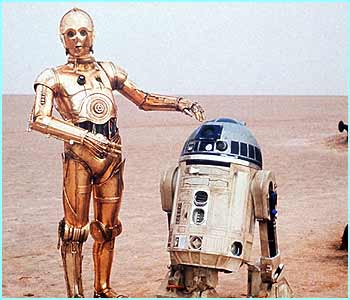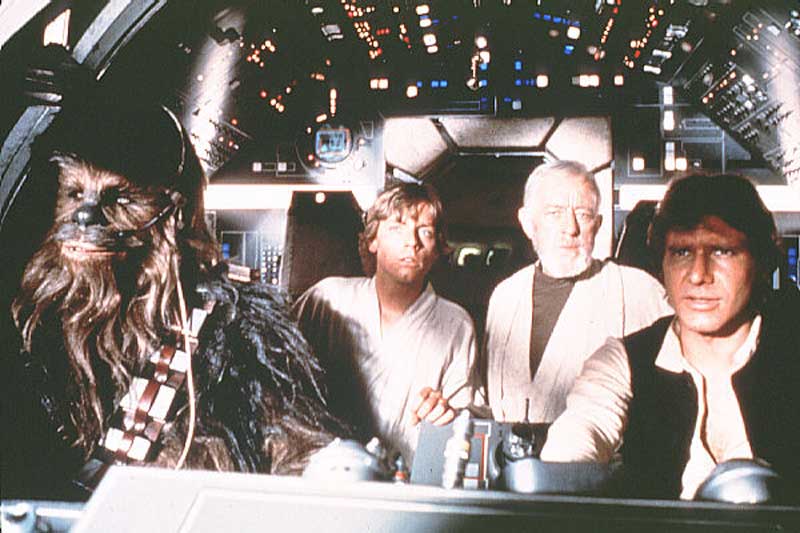A Brief History of Science Fiction Film Music
References, Links, and Works Cited
Created by Jessica Rooney
Last updated 5/1/06


Star Wars: A New Hope (1977)
The Creation of Myth and Nostalgia in Star Wars through Music
As a film, Star Wars relies heavily on the use of nostalgic and mythic elements to make the story and scenarios seem believable. At the end of the 1970s audiences were feeling a need to experience security in the drama and adventure of Saturday afternoon serials, and so Star Wars was able to “gratify a deeper and…nostalgic desire to that older period” (Lerner 98). In the film, music helped to awake this “sense of the past” that audiences craved (Lerner 98). The music is reminiscent of a experience in a theatre, following action and adding significance and subtleties to the spoken dialogue. For example, when Luke Skywalker, Hans Solo, Chewbacca, and Obi-won Kenobi first see the Death Star, Hans Solo dismisses it as no more than a moon. But moments later the relative silence Lucas uses to designate space is broken by an ominous horn call, and both the audience and Obi-won realize that “that’s no moon.” The atmosphere in the cockpit immediately changes, causing the sometimes flippant Luke to have a “very bad feeling about this” and resulting in the usually overly stubborn Solo to try and turn the ship around. The audience doesn’t know why it should be suddenly apprehensive, but the music creates emotions that the audiences feels almost without choice. This aides the mythic quality of the film, the music serving as a type of omnipotent ruler of emotion that the audience can not control or definitively identify.
Myths and legends also gain much of their atmosphere by their constant referral to the past, and this is accomplished in Star Wars through the music. The music is seemingly never brooding and any musical developments though modulation and variation prove to be inconsequential. “Time and again the music merely celebrates a return to what has already occurred” (Buhler 51), and this constant referral to a glorious (if never full specified) past helps give the film a legend-like quality. For example, in the end of the film, when Hans Solo and Luke accept their medals from Leia, the music draws upon the leitmotifs, but it also seems to speak of a form, culture, and tradition developed before and independently of this film. Legend bring with it connotations of history and cultural understanding, and the music of Star Wars provides these subtleties by serving as “an effective blend of memory, nostalgia, and manipulative power for the films’ less obvious arguments” (Lerner 97).
This ability to further ideas for audiences where words or visuals are inadequate also helps to aid in the mythical quality of Star Wars. By working both with and independently of sound effects and dialogue, the music can make “musical summaries” that give the music “a mythic substrate, a fluid semiosis that itself points to an intelligible realm beyond signification” (Buhler 40). This mythic quality also helps to validate the high emotion content in Star Wars. As a space opera, Star Wars is full of emotional content that borders on the melodramatic, but audiences accept this because the music is also somewhat exaggerated and expands these ideas. For example, the actions of Hans Solo are often so irrational, uncontrolled, and immature that there it would be hard for audiences to believe that he could succeed in his exploits. However, during such events as his fighting flight out of the Death Star back to the Millennium Falcon is so emotionally charged and heroic that it would seem even more illogical for him to fail. Similarly, when Obiwon is killed by Darth Vader, Luke yells out “No!” in a childish way that might have undermined his role as a strong character. But this outburst seems only natural at this point as the music rises in a crescendo of strings and horns, a musical outburst that draws on audience emotion and makes it seem that if Luke hadn’t cried out it would have been unnatural. The music in Star Wars contains elements of a love story, a drama, and an action film, and their combination in one continuous whole helps the audience tolerate Star Wars’s space-opera qualities.
